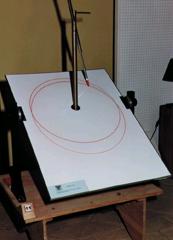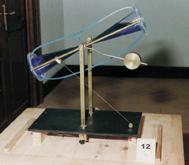- Straight lines and circles
- Conic sections
- Other curves
|
|




|
If we light up a wall with an electric torch keeping
it perpendicular to the wall, the lit portion is more or
less circular. Let's now begin tilting the torch upwards:
the circle deforms and assumes an oblong shape, like a
serving tray or a stadium: it's an ellipse.
If we keep
tilting the torch, the ellipse gets longer and longer.
While one of its ends remains near us, the other moves
further and further: if the wall were infinite, the lit
area would become bigger and bigger, until for a certain
inclination of the torch, it would become infinite. The
figure thus obtained is a parabola.
If we tilt the torch even further, the lit area
becomes even bigger, and it assumes the shape of a
hyperbole.
The three figures which are obtained one after the
other, or rather the curves that delimit them, are
collectively called conical sections, since they are
obtained sectioning a cone (in our case the cone of light
projected by the torch) with a plane (the wall).
|

|
Conical sections are often found in the most common
situations: a table lamp draws two hyperboles on the
wall, the shadow of a ball is an ellipse, a stone thrown
by a sling takes a parabolic path. In the past, the
theory of conical sections was essential to build
sundials. In its apparent motion, the sun draws a
circumference: the rays that pass by the tip of a
sundial's stylus then form a cone, that cut by the wall
creates a conical section, which at our latitudes is a
hyperbole, on which the shadow of the stylus's tip moves.
|

|
One can draw an ellipse using the great
three-dimensional compasses which the Arab geometers
had called the perfect compasses. The inclined
rod that rotates around the vertical axis describes a
cone, which is intersected by the drawing plane.
According to the latter's inclination, one can obtain a
circumference (if the plane is horizontal) or an ellipse,
longer the more inclined the plane. If one could increase
indefinitely the plane's inclination, one would obtain
first a parabola and then a hyperbole.
|

|
In the same way, depending on the machine's
inclination, the plane of the water, which is always
horizontal, intersects the water according to an ellipse,
a parabola or a hyperbole. A second cone, symmetrical to
the first, shows the two branches of the hyperbole.
|

|
Other elliptical compasses, some of which are
exhibited, can be built using the various properties of
this curve: one can also find them on sale. A parabola or
a hyperbole are more difficult to draw.
|
|
|